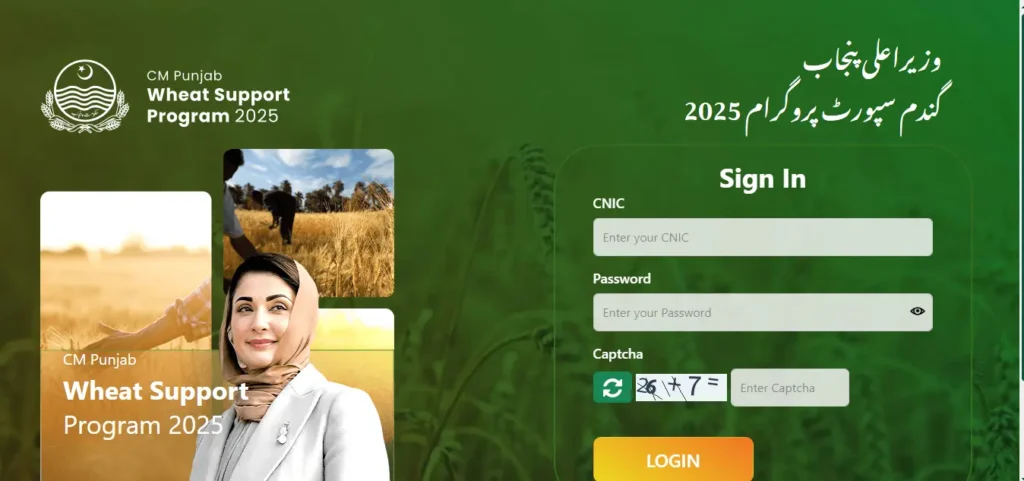CM Punjab Wheat Support Program 2025 – Online Registration, Subsidy, Benefits & Eligibility Guide

The CM Punjab Wheat Support Program 2025 is one of the most important subsidy schemes ever launched by the Government of Punjab. Its main purpose is to provide direct financial support to small and medium farmers, especially those struggling with high costs of wheat cultivation. Under this initiative, eligible farmers will receive a subsidy of PKR 5000 per acre, provided their total landholding does not exceed 12.5 acres.
Unlike older subsidy programs, this scheme is designed to be transparent, digital, and inclusive. Both landowners and tenants (bataidars) are covered, ensuring that financial support reaches every hardworking farmer who is actually cultivating wheat. This makes the program fair and effective, closing the gap between those who own land and those who rent it.
Why Was the Wheat Support Program Introduced?
Punjab is Pakistan’s breadbasket. The province alone contributes more than 70% of the country’s wheat production, feeding millions of people. But over the last decade, wheat growers have faced several problems:
- High input costs: Prices of fertilizer, seeds, diesel, and pesticides keep rising.
- Climate challenges: Erratic rainfall, floods, and droughts affect yields.
- Financial pressure: Small farmers depend on loans from middlemen at very high interest rates.
- Market instability: Wheat procurement prices often fail to match the actual cost of production.
These challenges not only reduce farmer incomes but also threaten national food security. By introducing the CM Punjab Wheat Support Program 2025, the government is directly addressing these issues with timely financial assistance.
Who Will Benefit From the Program?
The scheme is focused on small and medium farmers — the backbone of Punjab’s agriculture.
- Landowners with up to 12.5 acres who cultivate wheat.
- Tenant farmers who rent land but face the same production costs as owners.
👉 For example:
- A farmer with 8 acres of wheat land will receive PKR 40,000 subsidy.
- A tenant farming 5 acres will get PKR 25,000 subsidy.
This financial relief helps farmers cover essential expenses like fertilizer, irrigation, and harvesting costs.
What Makes This Program Different?
Earlier, subsidy programs in Pakistan often faced criticism because:
- Large landlords captured most of the benefits.
- Middlemen created corruption in disbursement.
- Tenants were usually ignored.
The CM Punjab Wheat Support Program 2025 solves these problems by:
- Setting a 12.5-acre limit to exclude big landlords.
- Using PLRA Girdawri verification and Deputy Commissioner inspections to confirm eligibility.
- Routing payments directly through the Bank of Punjab (BOP) to ensure transparency.
- Including tenants alongside landowners.
Punjab Wheat Subsidy 2025 Eligibility Criteria for Owners & Tenants
Eligibility is the first filter to ensure subsidy goes to the right people.
- Who Can Apply?
- Landowners with up to 12.5 acres of wheat cultivation.
- Tenants cultivating wheat on rented or shared land.
- Maximum Landholding
- 12.5 acres is the upper limit.
- Farmers with more land are not eligible.
- Land size is calculated by combining all plots owned or rented.
- Verification Process
- Digitized mauzas → eligibility checked automatically via PLRA Girdawri.
- Non-digitized mauzas → Deputy Commissioner’s office verifies through physical inspection.
👉 Example:
- A farmer with 8 acres will get PKR 40,000 subsidy.
- A farmer with 14 acres will be rejected.
This ensures only small farmers receive the support.
Punjab Wheat Support Program Registration 2025 – Step-by-Step Guide
Applying for the CM Punjab Wheat Support Program 2025 is simple, fast, and fully digital. The government has introduced an online registration portal so farmers no longer need to depend on agents or spend extra money to apply. By using your CNIC and mobile number, you can complete the process within minutes.
Step 1: Visit the Official Portal
Start by going to the official registration website:
👉 https://wsp2025.punjab.gov.pk/login
This is the only official website. Farmers should be careful of fake websites or agents demanding fees. Registration is completely free.
Step 2: Login with CNIC
- Enter your 13-digit CNIC number in the login field.
- Confirm your identity through a One-Time Password (OTP) sent to your registered mobile number.
- Make sure the mobile number is linked with your CNIC, otherwise the OTP will not be delivered.
👉 Example: If a farmer enters CNIC but his mobile number is not registered with NADRA, the login will fail. In that case, he must update his SIM registration first.

Step 3: Add Farmer Details
Once logged in, visit the data entry section here:
👉 https://wsp2025.punjab.gov.pk/add-farmer
You will need to fill in the following details:
- Full Name (as per CNIC)
- Father’s Name (for identity verification)
- CNIC number
- Tenancy Type → select Owner or Tenant
- Total Landholding Size (in acres)
- Crop Details → confirm that wheat is being cultivated
👉 Tip: Double-check every field. Even a small mistake (like an extra digit in CNIC or wrong land size) can cause rejection.
Step 4: Land Verification
This is the most important stage.
- If the mauza (village) is digitized → The Punjab Land Records Authority (PLRA) will automatically fetch your land record and crop details. Approval is usually quick.
- If the mauza is not digitized → Your case will be sent to the Deputy Commissioner’s (DC) office. Officials will physically verify land size and wheat cultivation before approving the application.
👉 In digitized areas, verification may take a few hours to 2–3 days. In non-digitized areas, it can take a week or longer.
Step 5: Approval & Payment
- Once landholding and crop details are verified, the case is approved by the system.
- Approved cases are forwarded automatically to the Bank of Punjab (BOP) through a secure API.
- The Bank of Punjab issues a pay order in the farmer’s name.
- Farmers can collect their subsidy from the nearest BOP branch.
👉 Example: A farmer with 10 acres will get a pay order of PKR 50,000 subsidy. He simply visits his local BOP branch with CNIC to receive payment.
Pro Tips for Farmers
- Keep your CNIC and tenancy documents updated before applying.
- Make sure your mobile number is active and registered with CNIC.
- Apply early to avoid last-minute rush.
- Check the status of your application regularly on the portal using CNIC.
- Always use the official website — avoid agents and fake registration offers.
Punjab Wheat Subsidy WSP Documents 2025 – Application Requirements Explained
Keep documents ready before applying:
- CNIC (original and copy).
- Proof of land ownership (owners).
- Tenancy agreement or landlord’s written statement (tenants).
- Updated Girdawri record showing wheat cultivation.
- Active mobile number.
- Bank account details (if required).
👉 If tenancy is oral, tenants must get a written verification from the landowner to avoid rejection.
Bank of Punjab Wheat Subsidy 2025 – Disbursement & Payment Process
Payments are routed only through the Bank of Punjab (BOP) for transparency.
- Approved applications arrive via API.
- BOP issues a pay order in farmer’s name.
- Farmers collect payment from their nearest branch.
Why BOP?
- Strong digital integration with government portals.
- Rural branch network.
- Zero tolerance for middlemen.
👉 Example:
A farmer with 10 acres receives PKR 50,000 subsidy from his local BOP branch.
PLRA Girdawri Verification for Punjab Wheat Subsidy Program 2025
What is Girdawri?
Girdawri is the official record of crops cultivated on land. It confirms whether wheat is grown or not.
Digitized Villages
- PLRA automatically matches CNIC with land record.
- Approval is fast (hours to a few days).
Non-Digitized Villages
- DC office verifies physically.
- Slightly longer process but ensures inclusion.
👉 Farmers should update their land records regularly at PLRA centers.
Punjab Wheat Subsidy for Tenants 2025 – How to Apply Online
Tenant farmers often face exclusion, but this program includes them.
- Register online with CNIC.
- Provide tenancy details.
- Submit tenancy agreement or landlord’s statement.
- Get verified through PLRA or DC’s office.
- Collect subsidy via BOP.
👉 Example:
A tenant farming 5 acres will receive PKR 25,000 subsidy.
Punjab Wheat Subsidy Application Mistakes to Avoid in 2025
Avoid these mistakes:
- Entering incorrect CNIC.
- Declaring land size above 12.5 acres.
- Not attaching tenancy proof.
- Submitting outdated Girdawri.
- Ignoring SMS verification.
👉 Always double-check before submission.
Benefits of Punjab Wheat Subsidy 2025 for Small Farmers
The CM Punjab Wheat Support Program 2025 is not just about giving money — it is about creating long-term change in Punjab’s agriculture. For decades, small farmers have struggled to cover their costs and survive market fluctuations. With this program, the government is directly targeting the issues that keep farmers trapped in debt and low productivity.
1. Financial Relief for Small Farmers
The biggest advantage is the PKR 5000 per acre subsidy. This financial support helps farmers cover a significant portion of their input costs.
- A farmer with 5 acres receives PKR 25,000.
- A farmer with 10 acres receives PKR 50,000.
👉 Why this matters: Seeds, fertilizer, and tractor rent are the largest expenses for farmers. Even a small financial push can decide whether a farmer plants wheat on time or delays cultivation.
2. Encouragement for Higher Wheat Cultivation
With reduced costs, farmers are encouraged to cultivate more land under wheat instead of shifting to less reliable crops. This not only improves farmer income but also ensures a steady supply of wheat for Punjab and the rest of Pakistan.
👉 Example: A farmer who cultivated only 6 acres last year may now cultivate his full 10 acres because subsidy reduces the risk of loss.
3. Fair and Inclusive Coverage
One of the most unique features of this program is that both owners and tenants (bataidars) are eligible. In previous subsidy schemes, tenants were often ignored. But in Punjab, a large share of farmers are tenants, so excluding them meant half of the real growers got no support.
This time, both categories are covered:
- Owners receive subsidy for their cultivated land.
- Tenants can apply with tenancy proof and get the subsidy directly.
This creates fairness and inclusivity in the system.
4. Stronger Food Security for Punjab and Pakistan
Punjab produces more than 70% of Pakistan’s wheat. If small farmers reduce cultivation due to high costs, the whole country faces shortages. By supporting wheat production at the grassroots level, this program ensures:
- More wheat is planted.
- More grain is available for flour mills.
- Prices of atta (flour) remain stable.
This is not just farmer welfare — it is national food security policy in action.
5. Reduction of Farmer Debt
Traditionally, small farmers borrow from arthis (middlemen) at interest rates as high as 25–30%. These debts trap farmers in a cycle of poverty.
By receiving subsidy, farmers can buy inputs with their own money instead of taking loans. This reduces dependence on informal credit markets and protects them from exploitation.
6. Boost in Yield and Productivity
Financial relief allows farmers to use better seeds, timely fertilizer, and improved irrigation. This results in higher yields and better quality wheat.
👉 Case Example:
Farmer Khalid from Southern Punjab had 7 acres. He received a PKR 35,000 subsidy under the program. He invested the money in urea and DAP fertilizer, which he could not afford before. As a result, his wheat yield increased by 15%, giving him higher profit at the end of the season.
7. Psychological Relief and Motivation
Often ignored, but very important: financial stress makes farmers lose motivation. Knowing that the government is backing them with cash support gives them confidence to plan ahead, plant on time, and expect a fair harvest.
8. Economic Ripple Effect in Rural Punjab
When farmers have more money, they spend more in local markets on services, shops, and inputs. This creates a positive chain reaction in rural economies, boosting employment and trade.
Phase 2 of CM Punjab Wheat Support Program 2025
The government has confirmed that Phase 2 is coming soon via the Chief Minister’s Unit (CMU).
Expected features:
- More non-digitized mauzas included.
- Faster PLRA integration.
- Mobile banking & digital wallets for payments.
- Possible inclusion of other crops.
Farmers should stay updated for announcements.
FAQs About Punjab Wheat Subsidy 2025:
1. Who can apply for the WSP program?
Landowners and tenants who have 12.5 acres or less of wheat cultivation.
2. How much subsidy is given per acre?
Each farmer will receive PKR 5000 per acre.
3. What is the maximum land size allowed?
Farmers with more than 12.5 acres are not eligible.
4. Can tenants (bataidars) also apply?
Yes, tenants can apply with a tenancy agreement or landowner’s statement.
5. Which bank is responsible for payment?
The Bank of Punjab (BOP) distributes the subsidy through pay orders.
6. What documents are required?
CNIC, land record, tenancy proof (if tenant), updated Girdawri, and mobile number.
7. What is PLRA?
The Punjab Land Records Authority, which verifies land ownership and crop details.
8. What is Girdawri?
It is the official crop record showing what is cultivated on each piece of land.
9. What if my village is not digitized?
The Deputy Commissioner’s office will verify your land manually.
10. How do I check my application status?
Login to the official portal with your CNIC to track status.
11. Is online registration free?
Yes, it is completely free. No agent or fee is required.
12. Can I apply from my mobile phone?
Yes, the portal is mobile-friendly and works on smartphones.
13. What if my application is rejected?
You can correct mistakes and reapply through the portal.
14. Is subsidy given in cash?
No, farmers receive a pay order from Bank of Punjab, not cash.
15. When will Phase 2 launch?
The government has announced Phase 2 will start soon, with more features and coverage.
Conclusion
The CM Punjab Wheat Support Program 2025 is a landmark farmer-friendly initiative. With PKR 5000 per acre subsidy, small farmers can reduce costs, increase productivity, and secure better harvests.
- Owners and tenants both included.
- Transparent verification through PLRA & DC offices.
- Payments distributed via Bank of Punjab.
- Phase 2 coming soon with even more benefits.
👉 Farmers should apply online now, prepare documents carefully, and avoid mistakes. This program is an opportunity to strengthen farming and ensure Punjab’s food security.
